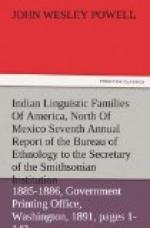= Adaize, Gallatin in Trans. and Coll. Am. Antiq. Soc., II, 116, 306, 1836. Latham in Proc. Philolog. Soc., Lond., II, 31-59, 1846. Latham, Opuscula, 293, 1860. Gallatin in Trans. Am. Eth. Soc., II, xcix, 1848. Gallatin in Schoolcraft Ind. Tribes, III, 402, 1853. Latham, Elements Comp. Phil., 477, 1862 (referred to as one of the most isolated languages of N.A.). Keane, App. to Stanford’s Comp. (Cent. and So. Am.), 478, 1878 (or Adees).
= Adaizi, Prichard, Phys. Hist. Mankind, V, 406, 1847.
= Adaise, Gallatin in Trans. Am. Eth. Soc., II, pt. 1, 77, 1848.
= Adahi, Latham, Nat. Hist.
Man, 342, 1850. Latham in Trans. Philolog.
Soc., Lond., 103, 1856. Latham, Opuscula,
366, 368, 1860. Latham,
Elements Comp., Phil., 473, 477, 1863
(same as his Adaize above).
= Adaes, Buschmann, Spuren der aztekischen Sprache, 424, 1859.
= Adees. Keane, App. to Stanford’s
Comp. (Cent. and So. Am.) 478, 1878
(same as his Adaize).
= Adai, Gatschet, Creek Mig. Leg., 41, 1884.
Derivation: From a Caddo word hadai, sig. “brush wood.”
This family was based upon the language spoken by a single tribe who, according to Dr. Sibley, lived about the year 1800 near the old Spanish fort or mission of Adaize, “about 40 miles from Natchitoches. below the Yattassees, on a lake called Lac Macdon, which communicates with the division of Red River that passes by Bayau Pierre."[6] A vocabulary of about two hundred and fifty words is all that remains to us of their language, which according to the collector, Dr. Sibley, “differs from all others, and is so difficult to speak or understand that no nation can speak ten words of it.”
[Footnote 6: Travels of Lewis and Clarke, London, 1809, p. 189.]
It was from an examination of Sibley’s vocabulary that Gallatin reached the conclusion of the distinctness of this language from any other known, an opinion accepted by most later authorities. A recent comparison of this vocabulary by Mr. Gatschet, with several Caddoan dialects, has led to the discovery that a considerable percentage of the Adai words have a more or less remote affinity with Caddoan, and he regards it as a Caddoan dialect. The amount of material, however, necessary to establish its relationship to Caddoan is not at present forthcoming, and it may be doubted if it ever will be, as recent inquiry has failed to reveal the existence of a single member of the tribe, or of any individual of the tribes once surrounding the Adai who remembers a word of the language.
Mr. Gatschet found that some of the older Caddo in the Indian Territory remembered the Adai as one of the tribes formerly belonging to the Caddo Confederacy. More than this he was unable to learn from them.
Owing to their small numbers, their remoteness from lines of travel, and their unwarlike character the Adai have cut but a small figure in history, and accordingly the known facts regarding them are very meager. The first historical mention of them appears to be by Cabeca de Vaca, who in his “Naufragios,” referring to his stay in Texas, about 1530, calls them Atayos. Mention is also made of them by several of the early French explorers of the Mississippi, as d’Iberville and Joutel.




